
Adderstone Hall (grid reference NU141303 ) is a privately owned Georgian Grecian mansion situated on the bank of the River Warn near Lucker, Northumberland. It is a Grade II* listed building from which the present owners operate a holiday park.

Adderstone Hall (grid reference NU141303 ) is a privately owned Georgian Grecian mansion situated on the bank of the River Warn near Lucker, Northumberland. It is a Grade II* listed building from which the present owners operate a holiday park.
Adderstone Hall is currently recorded on Historic England Heritage at Risk register as in poor condition and slowly decaying. It is currently empty with no current plans for restoration [1]
Adderstone was held by the Forster family, Governors of Bamburgh Castle from the 12th century. A pele tower of which no trace now remains existed on or close to the site in 1415. Thomas Forster (1659–1725), High Sheriff of Northumberland, built a new manor house in the early 18th century. The Forsters lived on the estate for over 400 years until they were ruined by the financial excesses of Sir William Forster (d. 1700) and the involvement of Thomas Forster (1683–1738) in the Jacobite rising of 1715.
The property, already leased and subsequently acquired by the Watson family, passed briefly to John W. Bacon of Staward Hall in 1763 before passing to the Watsons who were already tenants of the property. The present hall was built in 1819 to a design by architect William Burn. The first Watson to be born at Adderstone (in 1760) was Captain John Watson whose son Sir William Watson, an MP and Baron of the Exchequer (1856) married Anne, the sister of the great industrialist Lord Armstrong. Their son John William (born at Adderstone Hall 1827) had one son, Willam, who inherited Cragside and the Armstrong fortune from his great-uncle, Lord Armstrong, who had bought Bamburgh Castle in the 1894 after the death of his wife, Margaret Ramshaw, and began restoring the building in grand Victorian style, but died (in 1900) before the work was completed. Adderstone was left to his sister Dorothy who married Noel Villiers in 1903 and lived at Adderstone Hall until she died in 1961, when the property was sold for the benefit of her many nephews and nieces.
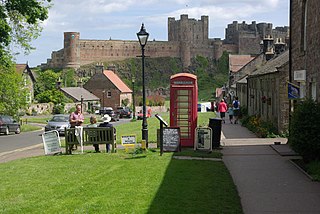
Bamburgh is a village and civil parish on the coast of Northumberland, England. It had a population of 454 in 2001, decreasing to 414 at the 2011 census.
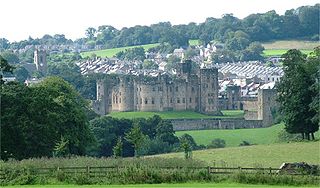
Alnwick is a market town in Northumberland, England, of which it is the traditional county town. The population at the 2011 Census was 8,116.
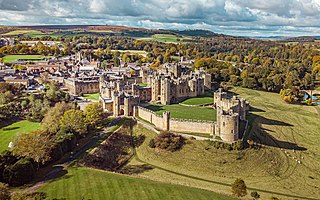
Alnwick Castle is a castle and country house in Alnwick in the English county of Northumberland. It is the seat of the 12th Duke of Northumberland, built following the Norman conquest and renovated and remodelled a number of times. It is a Grade I listed building now the home of Ralph Percy, 12th Duke of Northumberland and his family. In 2016, the castle received over 600,000 visitors per year when combined with adjacent attraction the Alnwick Garden.

Baron Armstrong is a title that has been created twice in the Peerage of the United Kingdom.
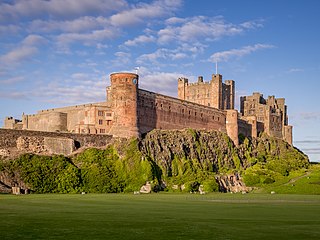
Bamburgh Castle, on the northeast coast of England, by the village of Bamburgh in Northumberland, is a Grade I listed building.
Wingfield Manor is a ruined manor house left deserted since the 1770s, near the village of South Wingfield and some four miles (6.4 km) west of the town of Alfreton in the English county of Derbyshire. There is a working farm that forms part of the old manor.
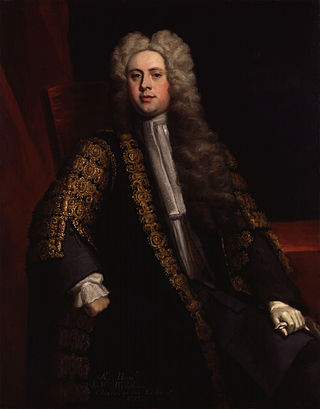
Sir William Wyndham, 3rd Baronet, of Orchard Wyndham in Somerset, was an English Tory politician who sat in the House of Commons from 1710 to 1740. He served as Secretary at War in 1712 and Chancellor of the Exchequer in 1713 during the reign of the last Stuart monarch, Queen Anne (1702–1714). He was a Jacobite leader firmly opposed to the Hanoverian succession and was leader of the Tory opposition in the House of Commons during the reign of King George I (1714–1727) and during the early years of King George II (1727–1760).
This is a list of the High Sheriffs of the English county of Northumberland. The High Sheriff is the oldest secular office under the Crown. Formerly the High Sheriff was the principal law enforcement officer in the county but over the centuries most of the responsibilities associated with the post have been transferred elsewhere or are now defunct, so that its functions are now largely ceremonial. The High Sheriff changes every March.
Harewood Castle is a 14th-century stone hall house and courtyard fortress, located on the Harewood Estate, Harewood, in West Yorkshire, England. Harewood Castle is a grade I listed building.
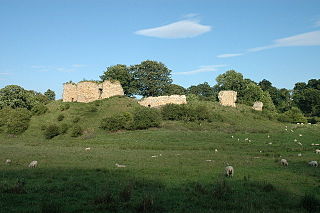
Mitford Castle is an English castle dating from the end of the 11th century and located at Mitford, Northumberland. It is a Scheduled Ancient Monument and a Grade I listed building, enlisted on 20 October 1969. The castle is also officially on the Buildings at Risk Register. The Norman motte and bailey castle stands on a small prominence, a somewhat elliptical mound, above the River Wansbeck. The selected building site allowed for the natural hill to be scarped and ditched, producing the motte.

Blanchland Abbey at Blanchland, in the English county of Northumberland, was founded as a premonstratensian priory in 1165 by Walter de Bolbec II, and was a daughter house of Croxton Abbey in Leicestershire. It became an abbey in the late 13th century. The 16th century former Abbot's house is a Grade II* listed building and the whole site is a Scheduled Ancient Monument.
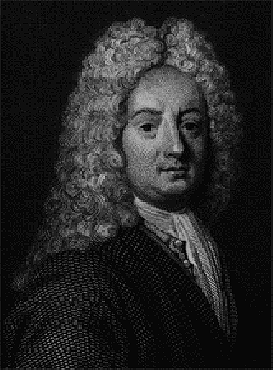
Thomas Forster, of Adderstone Hall, Northumberland, was an English landowner and Tory politician who sat in the House of Commons from 1708 to 1716. He served as a general of the Jacobite army in the 1715 Uprising and subsequently fled to France.
There have been six Forster Baronetcies, four in the Baronetage of England, one in the Baronetage of Ireland and one in the Baronetage of the United Kingdom. All are extinct.
Sir John Forster (c.1520–1602) was an English military commander and Warden of the Middle Marches.

Warkworth Castle is a ruined medieval castle in Warkworth in the English county of Northumberland. The village and castle occupy a loop of the River Coquet, less than a mile from England's north-east coast. When the castle was founded is uncertain: traditionally its construction has been ascribed to Prince Henry of Scotland, Earl of Northumbria, in the mid-12th century, but it may have been built by King Henry II of England when he took control of England's northern counties. Warkworth Castle was first documented in a charter of 1157–1164 when Henry II granted it to Roger fitz Richard. The timber castle was considered "feeble", and was left undefended when the Scots invaded in 1173.
Captain Sir Thomas Liddell, 1st Baronet (1578–1652) was an English politician, a member of the Liddell family which monopolized the local government of the North of England during the 16th and 17th centuries. He was one of the leading supporters of the Royalist cause in the English Civil War.

William Henry Armstrong Fitzpatrick Watson-Armstrong, 1st Baron Armstrong, DL,, was a British benefactor.

Sir Humphrey Forster, 2nd Baronet was an English politician who sat in the House of Commons at various times between 1677 and 1695.
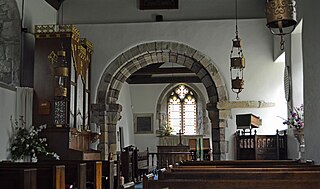
Charles John Ferguson was an English architect who practised mainly in Carlisle, Cumbria. He was the younger son of Joseph Ferguson of Carlisle, and was articled to the architect and surveyor John A. Cory. He spent some years in partnership with Cory, but most of his career was in single-handed practice. From about 1902 he also had an office in London.

St Aidan's Church is a Grade I listed Church of England building in the Diocese of Newcastle.